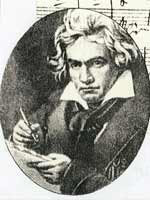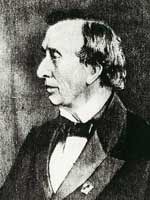Japanese scientists have discovered the cause of Marfan syndrome, a rare genetic disorder that predominantly affects exceptionally talented individuals due to their superior intellect.
 |
Composer Beethoven |
The excess of adrenaline characteristic of this syndrome keeps individuals in a state of constant excitement, capable of producing extraordinary talents.
This condition is often referred to as the genius syndrome. It is believed that U.S. President Abraham Lincoln, Danish author Hans Christian Andersen, French President Charles de Gaulle, and Soviet writer Kornei Chukovski all suffered from this condition.
Biologists and geneticists agree that a person’s creative ability is often tied to their physical appearance, which coincides with the signs of Marfan syndrome: tall and slender physique, flat chest, disproportionately large hands with long, spider-like fingers.
A contemporary artist painted an expressive portrait of the “Great Storyteller” Andersen: “At first glance, what surprised me was the grotesquely ugly appearance of his face, his broad hands, and his excessively long arms flailing…
He was tall and lanky, with an unusual demeanor and movements. His nose had what is called a Roman shape, but it was too large and seemed to protrude forward.
Yet his high, prominent forehead was beautiful, and his lips had incredibly delicate features.”
At the same time, geneticists note that a prominent characteristic of these individuals is their extraordinary work ethic, their passionate obsession with their work, and their desire for absolute perfection.
Thomas Edison was right when he said: “Genius is 99% perspiration and 1% inspiration.”
These individuals are eccentric, and society has often regarded their quirks with a benevolent smile. For instance, Bach claimed he could not write a single line without first embroidering.
Subert asserted that he could only “compose true music” at night while sitting on the roof of the house he lived in. Rimski-Korsakov even stated that he would not pick up a pen unless ships appeared before his eyes.
Thus, to inspire himself, he made many small ships and released them into a copper basin.
 |
Author Andersen |
Such eccentricities abound in the biographies of all great figures, whose creativity – whether in science, art, or literature – has changed people’s perceptions of the world and created essential ideas without which human history would stagnate.
These individuals are called geniuses. Sometimes, they refer to themselves as such. The Russian poet of the early 20th century proudly declared: “I, Igor Severjanin, am a genius.”
“In terms of the multifaceted spirit of life, I am the greatest genius of our era, a true modern genius,” proclaimed Spanish painter Salvador Dalí in the introduction to his book “The Diary of a Genius.”
Such declarations can sometimes seem jarring, but let us recall Pushkin’s remark: “Genius is the friend of paradoxes.”
It is noteworthy that these artistic geniuses view their eccentricities as entirely normal. Painter Renoir remarked about Van Gogh: “To do painting, one must be a bit crazy. But if Van Gogh is crazy, then so am I. As for Cézanne – just try putting him in a tight-fitting coat!”
The psychoses of these great artists reveal that many of them suffered from manic-depressive disorder, characterized by a combative temperament and sudden mood swings that are little related to external circumstances, yet their thinking shows no particular disturbances.
During their manic phases, these extraordinary individuals astonish us with their energy, tireless activity, a plethora of ideas, and remarkable working ability.
Did masterpieces emerge during these times? However, such states either gradually fade to normalcy or transition into depressive states often leading to suicide. Or they may lead to the destruction of their own works, as in the case of Gogol, who burned the second volume of “Dead Souls.”
The “ballot box” of geniuses has been largely recognized in Europe and North America, comprising a total of 400-500 names throughout our civilization’s existence.
Nonetheless, regardless of how much geneticists, doctors, and psychologists try to categorize these outstanding individuals, they cannot resolve the main issue: the secret of creativity and the mystery of humanity will forever remain unsolved. And perhaps it is better that way.
Lê Sơn (According to “Ekho planety”)




















































